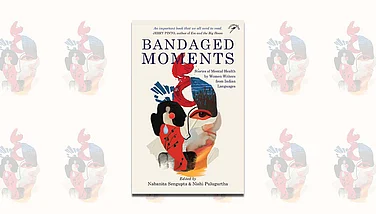At the heart is a love story between Lev, an un- or at least under-employed research scientist from St Petersburg, and Maya, an Indian woman twenty years his junior who is a puppeteer. Their affair is unexpected, unlikely, impossible—and entirely believable.
Isn’t it just like life, or fate, or whatever whimsical gods one believes in, to throw together these two unlikely humans and have them fall madly in love? They meet by chance—Lev has just landed in Delhi, his suitcase containing precious papers has been stolen, he is stranded, desperate, and alone. Sitting in the park, he is spotted by Laiq, a barber and Yunani physician and owner of the ‘brainfever bird’ (actually a partridge) of the title. Laiq invites Lev to his shop for a massage and it is there that he meets Maya, who lives in the flat upstairs—alone except for her puppets and the occasional visit from her best friend and sometime lover Morgan Fitch, a suave young newsreader.
Maya—of course, given her name—is an illusionist: a dreamer, a storyteller, a fabulist. She talks to her puppets (and listens to them). Maybe she’s a witch; she’s certainly bewitching. The morning she meets Lev, she awakes from a dream in which the question was posed: What sort of man shall be my lover? And there he is, delivered to her doorstep, as it were, by that specific mix of worlds-apart chance and mathematical logic (like two straight lines converging) that always heralds Romantic Destiny. To Lev, it feels like "he is infected with love. It rages in his body, the way her fever must have."
The medical metaphor is no accident. Maya doesn’t know, but Lev researches biological weapons, breeding and testing ever newer and deadlier strains of bacteria for governments who wish to wage biological warfare. It is hard to come up with a more potent image of human evil. Doctors who are anti-doctors; doctors who make people sick; who experiment with ever more efficient ways of delivering death—like the Nazi doctors of the Third Reich. Yet, here is Lev, poor bumbling fool that he is. Marriage on the rocks, career collapsed with the old Soviet Union, alienated from his teenage son, his mid-life crisis manifesting itself in time-honoured tradition by falling for a dusky beauty half his age. The human heart, Sealy tells us, is as strange a place as our modern world. Anthrax and love: each the other’s implacable opposite, and yet they coexist.
It’s no coincidence either that the photograph on the cover (which, coincidentally, is brilliant) shows a puppet moving. Humans-as-puppets is hardly a new idea. From Shakespeare to the cult classic movie Being John Malkovich, writers and artistes have always asked the question—who’s pulling the strings? Is it God? Fate? The Secret Service? The author himself as puppeteer for his characters? Freud explored the whole issue of the ‘unheimlich’—that mix of human/inanimate, familiar/strange that excites our interest in puppets and also makes them so spooky. Sealy’s book opens with a prologue in which he describes a puppet coming to life and creeping down the hallway and into your bedroom to look at you whilst you are asleep, "resting there as it absorbs the rhythm of your breathing". It’s enough to give you the collywobbles forever.
The twin themes of the book—puppets and plagues—are entwined with similar questions: what is natural and what is man-made? Who’s pulling the strings? But one reads Sealy not for the ideas, which are merely interesting, but for the sheer joy of his descriptive writing. Here’s one of the characters in St Petersburg: "The sun has gone, leaving a light the colour of the elderflower cordial his first night landlady dosed him on to check a slight cold". And again, carrying on the whole ‘puppet-show’ theme with the lightest of touches: "The sunset afterglow gives the further roofs and chimneys the carpentered look of a backlit stage set." On virtually every page, there’s a phrase or sentence which calls you back just to savour the magic that words can weave. Anyone who has been in Delhi on a scorching summer afternoon, just as the khaki sun is sinking, knows that calling the light "pear-coloured" is not just precise, it is inspired. Highly recommended.

























